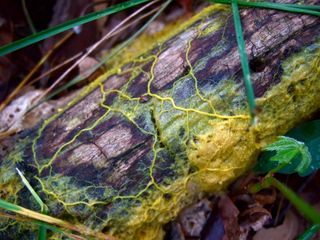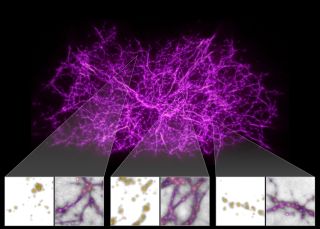Slime mold models help astronomers map filaments of the cosmic web
Earthly slime mold models have helped astronomers map the cosmic web that connects galaxies throughout the universe.
Slime mold, or Physarum polycephalum, is a single-cell organism that builds complex filamentary networks in search of food. Using computer models inspired by the growth patterns of slime mold, researchers from the University of California Santa Cruz traced the web-like network of interconnected filaments that extend light-years between galaxies.
"A slime mold creates an optimized transport network, finding the most efficient pathways to connect food sources," Joe Burchett, lead author of the study from UC Santa Cruz, said in a statement. "In the cosmic web, the growth of structure produces networks that are also, in a sense, optimal. The underlying processes are different, but they produce mathematical structures that are analogous."
Video: Fly through an amazing cosmic web visualization
Related: The 11 biggest unanswered questions about dark matter
To create the new models, the team used data from the Sloan Digital Sky Survey and the work of Berlin-based artist Sage Jenson, whose artistic visualizations are based on an algorithm for simulating the growth of slime mold. The researchers named the new algorithm the Monte Carlo Physarum Machine, according to the statement.
Matter in the universe is distributed in a web-like network of intergalactic filaments separated by huge voids. Galaxies form where these filaments intersect and matter is most concentrated. However, these filaments, which extend between galaxies, are largely invisible because they are made up of dark matter — a material that does not emit light or energy, but accounts for roughly 85% of the mass of the universe.
The researchers tested the new algorithm against data from the Bolshoi-Planck cosmological simulation. This simulation, which was developed by Joel Primack, a physics professor at UC Santa Cruz, is used to model "halos" of dark matter — in which galaxies form — and the filaments connecting galaxies across the universe. The results revealed that the outcome of the new slime mold algorithm closely aligned with the dark matter simulation, according to the statement.
Get the Space.com Newsletter
Breaking space news, the latest updates on rocket launches, skywatching events and more!

"Starting with 450,000 dark matter halos, we can get an almost perfect fit to the density fields in the cosmological simulation," Oskar Elek, co-author of the study and postdoctoral researcher in computational media at UC Santa Cruz, said in the statement.
The researchers also used data from the Hubble Space Telescope's Cosmic Origins Spectrograph, which is used to study objects that absorb or emit light. Intergalactic gas leaves a distinctive absorption signature in the spectrum of light that passes through it, according to the statement.
Thus, the Hubble data revealed gas signatures in the space between galaxies. The gas signatures were stronger toward the middle of filaments, where dense accumulations of matter form new galaxies, according to the statement.

"For the first time now, we can quantify the density of the intergalactic medium from the remote outskirts of cosmic web filaments to the hot, dense interiors of galaxy clusters," Burchett said in the statement. "These results not only confirm the structure of the cosmic web predicted by cosmological models, they also give us a way to improve our understanding of galaxy evolution by connecting it with the gas reservoirs out of which galaxies form."
Therefore, the new slime mold-based algorithm allows astronomers to visualize the cosmic web on a larger scale. Their findings were published March 10 in the Astrophysical Journal Letters.
- Neutrinos entangled in the cosmic web may change the universe's structure
- Our expanding universe: Age, history & other facts
- Space gets slimed: Tiny satellite will grow mold in orbit
Follow Samantha Mathewson @Sam_Ashley13. Follow us on Twitter @Spacedotcom and on Facebook.
OFFER: Save at least 56% with our latest magazine deal!
All About Space magazine takes you on an awe-inspiring journey through our solar system and beyond, from the amazing technology and spacecraft that enables humanity to venture into orbit, to the complexities of space science.
Join our Space Forums to keep talking space on the latest missions, night sky and more! And if you have a news tip, correction or comment, let us know at: community@space.com.

Samantha Mathewson joined Space.com as an intern in the summer of 2016. She received a B.A. in Journalism and Environmental Science at the University of New Haven, in Connecticut. Previously, her work has been published in Nature World News. When not writing or reading about science, Samantha enjoys traveling to new places and taking photos! You can follow her on Twitter @Sam_Ashley13.

